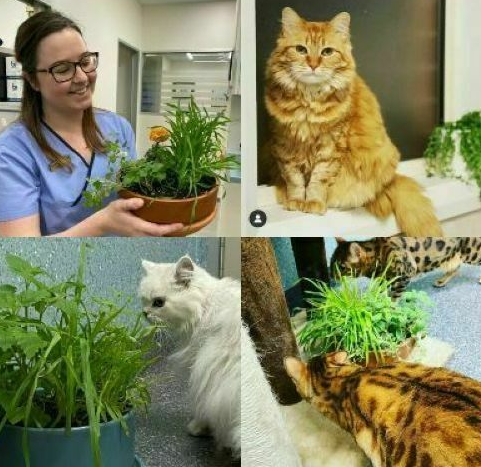We have seen lots of trends emerge in the socially distanced 2020 and beyond. Especially, things that make us happy during tricky times spent, in large part, at home. One of those things has been the resurgence of indoor plant popularity. Personally, I love gardening and indoor plants. I remember my parent’s indoor planters- they were built into the short wall between the lounge and dining room in the 80’s and 90’s. I love that it has become fashionable again!
It is all well and good to jump onto the “Crazy Plant Person” bandwagon, even if it does tend to be a hobby that increasingly hits the hip pocket, but we need to take into account the other members of our ever-growing indoor (and outdoor) jungles.
So this brings me to the topic of pets and plants- friends or foes?
When I am in plant-mum mode I sometimes think the pets are more of a risk to the plants than the other way around. In fact, I spent the weekend “cat and dog proofing” my potted herbs (after many crushed basil seedlings and damaged caper bush plants- which I have been babying for 2 years).
Despite their antics, or perhaps because of them (since they are obsessed with the plants sometimes) its important to consider how our plant choices may affect our pets. Many of our favourite flora and foliage can be unsafe for pets, mainly due to toxicity of the plant if consumed. The level of toxicity or type of adverse reactions caused can vary between different plants and species of pets.
I will be going over some the plants that are most important to avoid when you have dogs and cats. It’s important to remember though that other species such as rabbits, guinea-pigs, birds and lizards can all have sensitivities to things in the home, so if you have any questions or concerns always seek veterinary advice.
Plants that are toxic to pets:
Cats and Lilies
If your cats are anything like mine they are very nosey and like to explore every new thing that comes into the house. Often cats will bite plants and flowers in the house as well. As such, we have to be very careful of plants that we bring inside. Any plant in the Lilium family is very toxic to cats. The main example of this is the Oriental lily. The Oriental lily is the one we normally see in flower arrangements, with the stamens that drop lots of yellow orange pollen. They are toxic if eaten but more alarmingly if the cats brush past and get pollen on themselves- the pollen is toxic when they groom themselves clean!
It causes renal failure rapidly and as such if you suspect your cat has had exposure you should seek vet care immediately. Other flowering plants such as Day lilies, Calla lilies and Peace lilies are similarly toxic.
Dogs and Cycads
One of the outdoor plants that can be most worrying is the Sago palm or Cycad. It’s a very prehistoric looking plant (a cross between a fern and a tree) that is very popular in outdoor landscaping and gardens. However, every part of the plant (leaves, roots, flower/fruit) is highly toxic if consumed by your pet and causes acute liver failure. Always a concern if you have dog that chews on plants in the garden!
Indoor plants that are toxic:
Sadly, lots of the popular indoor plants (that often can be found in outdoor gardens too) are toxic to pets. Many plants that are marketed heavily right now are in the family ‘Araceae’.This family of plants contain insoluble calcium oxalate in their leaves which can cause nasty oral pain and swelling, drooling, trouble swallowing and vomiting if eaten. Plants in this family include (but are not limited to);
Fiddle leaf figs (Ficus lyrata)
Rubber fig (Ficus elastica)
Dumbcane (Dieffenbachia)
Fruit salad plant (Monstera deliciosa)
Devils Ivy (Epipremnum aureum)
Obviously, a lot of other plants are out there so it’s important to check whenever you are buying a plant to see if it will affect your furry, feathered or scaly friends. I usually use the ASPCA website, a UK website (similar to our RSPCA) that has an extensive list of plants and the classification of toxicity to animals. Lots of other resources are out there though, some more reliable than others.
If in doubt call the clinic for advice.
Indoor plants to add to our jungle
I thought I’d list a few plants that are reasonably safe (to dogs and cats) to add to your indoor jungle. The ASPCA does have the caveat that most plants if eaten in large amounts could cause a gastrointestinal upset, the following have not got components that are directly toxic to dogs or cats:
Spider plants (Chlorophytum comosum)
Aluminium plant (Pilea cadieri)
Chinese money plant (Pilea peperomioides)
Prayer plant (Calathea insignus)
Zebra haworthia (Haworthia fasciata)
Boston fern (Nephrolepis exalta bostoniensis)
Maidenhair fern (Adiantum raddianum)
Or maybe you want to make pet friendly plant pots using “cat grass”, “cat mint/catnip” and other fragrant but safe herbs that your pets can sniff and rub against worry free! As we like to say- they can go on Sniff-ari!
These plants are easily sourced in the herb section of your local garden centre.
I hope this helps anyone who loves plants and has pets. The key is to consider how your pets interact with anything in your house, the types of toxins plants have and how it might affect your pet and to investigate if you are ever unsure.
Enjoy your indoor jungles!
Written by Dr Michelle Lloyd, Our cat-loving, plant obsessed Vet. For more cat and doggy spam with a hint of plants you can follow her on Instagram @michelle_the_vet






